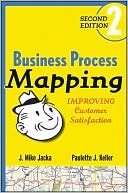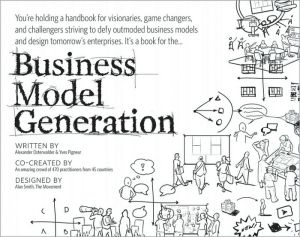Business Process Mapping: Improving Customer Satisfaction
Search in google:
Whether you are looking for a way to createefficiencies, analyze the work that is being done, or provide better customer service or innovation, you are ultimately looking for a tool to better understand processes. A full and complete introduction toorganizational processes, growth, and businesstransformation, Business Process Mapping: Improving Customer Satisfaction, Second Edition is that tool. Now providing more detailed work and examples related to customer mapping and enterpriserisk management (ERM), the Second Editionfocuses particularly on how objectives, risks, andkey performance indicators are fundamental tounderstanding and analyzing processes. Its case studies and a wide range of new tools, including RACI matrices, "spaghetti" maps, and the use of control flowcharts, enhance and enrich the basic work done to get you successfully mapping using a more robust approach to process analysis. Starting with a concept that is the cornerstone of moviemaking-storyboarding-the Second Editionwalks you through the steps used in processmapping, including:Working with the client to ensure that everyone has a full understanding of the processes involvedLearning the underlying concepts behind the process such as objectives, risks, and key controlsBuilding the actual maps that are the cornerstone of this approachUsing various approaches to help determine how to make the process better This practical book discusses the complete cycle of business process mapping and links business objectives, risks, and measures of success to the processes being mapped. In addition, the Second Edition now includes questionnaires, process analysisworksheets, hierarchy/owner maps, and specific techniques to be used in developing effectiveprocess maps. Ultimately, process mapping is a dynamic analytical technique meant to make your business run better. Drawing on their unique experience and expertise in the area of business process mapping, authors Mike Jacka and Paulette Keller reveal their simple yet powerful approach to process mapping as aneffective analysis tool-whether you are workingwithin the department, within the company, orexternally. Its holistic approach transforms flowcharting into a powerful, customer-focused tool for business improvement.
Preface. Introduction. Pinocchio and the World of Business. Chapter 1 What Is This Thing Called Process Mapping? Who Cares about Processes, Anyway? “Tell Me a Story”: Analyzing the Process. Benefits. The Process of Process Mapping. Process Defined. Drilling Down the Movie. Business Processes as Movies. A Real Business Example. Recap. Key Analysis Points. Chapter 2 Process Identification. What Do You See? Finding the Story. Trigger Events. Naming the Major Processes. Process Timelines. Customer Experience Analysis. Recap. Key Analysis Points. Chapter 3 Information Gathering. What You Need to Know and Where You Go to Learn It. Preliminary Information. Process Identification. Process Description Overview. Identifying the Process Owners. Meeting with the Process Owners. What to Discuss. Process Profile Worksheet. Meeting with the Unit Owners. Workflow Surveys. Data Gathering. Recap. Key Analysis Points. Chapter 4 Interviewing and Map Generation. Creating the Storyboard (Finally). Ground Rules. Sticky-Note Revolution. Basic Rules. Conducting the Interviews. Creating a Final Map. Example. Recap. Key Analysis Points. Chapter 5 Map Generation: An Example. Try It—You’ll Like It. Unit Level. Task Level. Action Level. Recap. Key Analysis Points. Chapter 6 Analysis. Into the Editing Room. Triggers and False Triggers. Inputs and Outputs. Process Ownership. Business Objective. Business Risks. Key Controls. Measures of Success. Analyzing the Actual Maps. Cycle Times. Finalizing the Project. Recap and Key Analysis Points. Chapter 7 Map Analysis: An Example. This Is Only an Attempt. Process Profile Worksheet. Analyzing the Maps. The Bigger Picture. Recap and Key Analysis Points. Chapter 8 Pitfalls and Traps. Challenges. Mapping for Mapping’s Sake. Lost in the Details. Penmanship Counts. Round and Round, Up and Down. Failure to Finalize. Letting the Customer Define the Process. Leading the Witness. Verifying the Facts. Do Not Forget the Customers. Recap. Key Analysis Points. Chapter 9 Customer Mapping. Identify Jobs the Customer Wants to Get Done. Customer Mapping versus Process Mapping. The Steps of Customer Mapping. The Customer Profile Worksheet. Customer Mapping Example. WeTrainU Customer Mapping Example. Spaghetti Maps. Recap. Key Analysis Points. Chapter 10 RACI Matrices. Process versus Authority. How Do I Know There’s a Problem? What Is a RACI Matrix? Analyzing the RACI Matrix. Expense Payment Process Example. RACI Matrix to Process Map. Process Map to RACI Matrix. Recap. Key Analysis Points. Chapter 11 Enterprise Risk Management and Process Mapping. Efficiency versus Effectiveness. Enterprise Risk Management: A Primer. And Now for Process Mapping. The Internal Environment. Objective Setting. Event Identification. Risk Assessment. Risk Response. Control Activities. Information and Communication. Monitoring. Recap. Chapter 12 Where Do We Go from Here? Additional Applications. Control Self-Assessment. Re-Engineering. Training. That’s Not All, Folks! Index.








